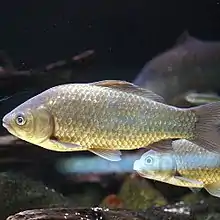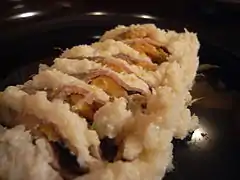Nigorobuna
Nigoro-buna, sometimes called round crucian carp, is a type of wild goldfish (Carassius auratus grandoculis) or related cyprinid (Carassius buergeri grandoculis) endemic to Japan. Its habitat is limited to Lake Biwa, its tributaries and distributaries, and irrigation canals, in the Shiga Prefecture (west-central Honshu), northeast of Kyoto.

The fish is of culinary importance locally in Shiga Prefecture, where it is used as an ingredient for funazushi, a type of narezushi. The fermented fish is closely packed with rice and salt in tubs.
Etymology
The Japanese name nigorobuna (ニゴロブナ) has been ascribed various etymologies. One has it that it earned the name ni-gorō-buna (Japanese: 似五郎鮒) meaning "gorō-buna's look-alike", because once it attains sizes of approximately 1.2–1.3 shaku (≈feet), it begins to look confusingly similar to the gengorō-buna (源五郎鮒) (C. cuvieri, the wild form of the Japanese crucian carp) which is a closely related species that is also endemic to the lake.[1] It is alternatively styled nigorobuna 煮頃鮒, which crudely translates to "braising-timely-carp".
Taxonomy
Some literature refer to nigorobuna as subspecies Carassius auratus grandoculis,[2]
It is also given as subspecies Carassius buergeri grandoculis in governmental and academic literature as well as the Japanese database.[3][4][5] The subspecies exhibits polyploidy.[6]
Morphology
A typical adult nigorobuna attains 35 cm (14 in)length at maturity.[8][11]
Its shape resembles the nagabuna[lower-alpha 1] that populate Lake Suwa;[12] its body depth is short, and breadth is wide.[12][13]
The head is large, with a ventricular contour that is characteristically ridged.[12][13] The mouth slit is slanted upwards.[12][13] Around 61 (or 52–72) gill rakers can be counted, and the dorsal fin rays consist of one spine and 17 (or 15 to 18) soft rays. The anal fin has one spine and five soft rays.[13] The basal length of the dorsal fin is rather long.[13] The total length is 2.7× the body depth.[13]
Behavior
Larvae and juveniles are found on the surface and medium depths entrenched within reeds[13] around the lake, in other words, inlets rich in aquatic plants.[14] Adults occupy shallower waters in summer and move to deeper waters during the cold winter.
One study showed that when larvae of about 1 cm length were compared, nigorobuna was "scarce(ly)" feeding on algae, compared with local genogoro-buna, which had 25–50% algal digestive tract content by bulk.[15] The fish showed a preference for certain water fleas over another, relying heavily on Chydorus spp.[lower-alpha 2] and to a lesser extent on Mesocyclops. By contrast, the gengoro-buna kept in the same enclosure preferred rotifer spp. The fry (larvae) of both species largely ignored other types of zooplankton (such as Alona, Scapholeberis, and copepodid larvae) which were plentiful.[16] As they grow into juveniles exceeding 1 cm, the nigorobuna begin pecking at aquatic plants to feed on attached algae, so by the time they attain 2 cm lengths,[13] algae account for half their diet (and rotifers represent a small percentage).[17] When they grow larger, they capture somewhat bottom-dwelling zooplankton.[13]
Adults spawn from April to June, laying eggs on aquatic plants when water levels rise due to the rainy season.[13] The hatchlings live by the reedy shore, and move offshore as they grow, reaching full size in 2 to 3 years.[18]
Uses

This is a highly prized fish commercially, made into funazushi, where whole fish are salted and fermented in beds of cooked rice. An authentic funazushi traditionally must use the "round crucian carp", and for this reason it has been dubbed sushi-buna meaning "the crucian carp for sushi". The dish, a type of narezushi, is a local delicacy of Shiga Prefecture, and known for its pungent odor.[19][20]
This species is said to make superior funazushi that is tender down to the bones, in contrast to imitations made by using gengoro-buna (Carassius cuvieri) as a substitute.[10] The ginbuna (Carassius langsdorfii) is also said to be used as a substitute.
Fishing regulations
The annual catch was estimated to be 500 tons in 1965, fell to 178 tons by 1989, and drastically down to 18 tons by 1997[18] so that efforts were begun to release fishery-raised spawn into nearby rice paddies connected with the water system.[18] Nowadays, the species is also farmed in Saitama Prefecture.[21]
Shiga Prefecture, in its announced project to recover the fish stock, promulgated rules through its Lake Biwa Fisheries Management Commission, effective April 1, 2007, prohibiting the capture of fish measuring 22 cm or less.[22]
Vulnerability
The Japanese Ministry of the Environment's published Red List (2018) listed the fish subspecies as endangered (IB).[3]
The devastation of numbers is blamed on habitat loss (spawning ground), as well predation by introduced species.[23] Adults are known to be taken by black bass, and the larvae and eggs are fed on by bluegill, both of which have become invasive in the Lake.[24]
The impact of predatory fish may be a secondary aggravating factor, the core cause being man-made changes to the lake's landscape according to some opinion.[25]
The nigorobuna's spawning grounds are the reed belts in Lake Biwa and the lagoons attached to the lake referred to as naiko (内湖), as well as rice paddies. Most of the reed belt zones were altered by the lake shore dykes project (1976–1991), the number of lagoons fell to just over twenty,[lower-alpha 3] and by 1995 the total lagoon area was 425 ha (1,050 acres) (15% of the total size in 1940). Also the canals connecting the bodies of water were fitted with sluice gates, hampering the fish from traveling.[26]
The current situation is not well-described as blockage by gates; the farmland consolidation (hojō- seibi) project was conducted that raised the ground of the rice paddies,[27] and instead of drawing water from canals, these farms switched to pumping water via PVC pipes, depriving the aquatic life of their conduits to enter.[26][25].
Explanatory notes
- The MOE Red databook gave "subspecies 1", and FishBase (version of 2006) gave this subspecies C. a. buergeri. But FishBase no longer lists this subspecies.
- Cf.
 Data related to Chydorus at Wikispecies.
Data related to Chydorus at Wikispecies. - Reclaimed to be converted to rice paddies, and so forth.
References
- Hitomi, Hitsudai (1981), Yoshii, Hatusko; Shimada, Isao (eds.), Honchō shokkan 本朝食鑑, 5, Heibonsha, p. 267, ASIN B000J80JPO,
又此魚ノ大ナルモノ、一尺二三寸位ナルモノハ源五郎鮒二似タリテ、故ニ似五郎ト呼ブト云フ説ヲ優レリトス
- e.g., Fujioka, Y. (1997). Production and some properties of gynogenetic diploids in nigorobuna crassius carassius grandoculi, Bull. Shiga. Prefect. Fis. Exp. Stn. 46, 108, cited by Arai, Katsutoshi (2001) Genetic improvement of aqualculture finfish species by chromosome manipulation techniques in Japan".
- "【Kisui/tansui gyorui】Kankyōshō Redlist 2018" 【汽水・淡水魚類】環境省レッドリスト2018 (PDF). Ministry of the Environment (Japan). 2018. Retrieved 2019-07-10.
- Yamanaka, Hiroki (2013), "Hypoxic conditions enhance refuge effect of macrophyte zone for small prey fish from piscivorous predators", Fisheries Management and Ecology, Wiley, 20 (6): 465–472, doi:10.1111/fme.12033 doi:10.1111/fme.12033
- "Carassius auratus grandoculis". DNA Data Bank of Japan. 2016-09-02. Retrieved 2019-07-10.
- Tabata, Ryoichi; Kakioka, Ryo; Tominaga, Koji; Komiya, Takefumi; Watanabe, Katsutoshi (2016), "Phylogeny and historical demography of endemic fishes in Lake Biwa: the ancient lake as a promoter of evolution and diversification of freshwater fishes in western Japan", Ecology and Evolution, Wiley, 6 (8): 2601–2623, doi:10.1002/ece3.2070, PMC 4798153, PMID 27066244 doi:10.1002/ece3.2070
- Fujioka 2013, p. 57.
- Nihon no tansuigyo (1989) gives 35cm; and its 2nd ed. has 20-35 cm.[7]
- Okada, Yō 岡田要; Uchida, Seinosuke 内田清之助; Uchida, Tōru 内田亨, eds. (1965). Shin nihon dōbutsu zukan 新日本動物図鑑. 3. Hokuryūkan. p. 204.
- Gomyō & Furukawa (2005), Shokuzai kenkō daijiten, p. 303
- Shin nihon dōbutsu zukan gives 200-400 mm,;[9]Shokuhin kenkō daijiten gives 35-40 cm (13¾-15¾ inches).[10]
- Nihon no tansuigyo (1989), p. 344.
- NIES (2012-03-30). "Carassius auratus grandoculis". National Institute of Environmental Studies. Retrieved 2019-07-10.; cited sources include Froese & Pauly (eds) (2009) FishBase and Nihon no tansuigyo (3rd ed., 2002).
- Hirai (1969)
- Naofusa, Hirai (1969). Japanese Shinto. International Society for Educational Information, Inc. OCLC 12931200.
- Hirai (1969), p. 124, Tables 1
- Hirai (1969), p. 124, Tables 2
- Fisheries Management Division (2007)
- Kawanabe, Hiroya; Coulter, George W.; Roosevelt, Anna Curtenius (1999), Ancient Lakes: Their Cultural and Biological Diversity, Kenobi Productions, p. 228, ISBN 9789080434127
- Kawanabe, Hiroya; Nishino, Machiko; Maehata, Masayoshi (2012), Lake Biwa: Interactions between Nature and People, Springer Science & Business Media, p. 346, ISBN 9789400717831
- Kuzushima, Kazumi (葛島一美); Kumagai, Masahiro (熊谷正裕) (2011). Nihon tanago tsuri kikō 日本タナゴ釣り紀行. Tsuribito-sha. ISBN 9784885361883., p.40
- Lake Biwa Fisheries Management Commission (2007)
- Fujioka (2013), p. 59.
- Fujioka (2013), p. 60.
- Okuda, Noboru 奥田昇 (2009), "Panel discussion: mizube no tsunagari ga hagukumu Biwa-ko no seibutsu tayōsei" <パネルディスカッション>水辺のつながりが育む琵琶湖の生物多様性, Tokeidai taiwa shūkai, 5: 52–59, hdl:2433/176953
- Fujioka 2013, pp. 59–60.
- To prevent the paddies from being flooded whenever the water level of the lake went up.
Bibliography
- Fujioka, Yasuhiro 藤岡康弘 (2013), "Biwako koyū (a)shu honmoroko oyobi nigorobuna gengorōbuna gekigen no genjō to kaifuku e no kadai" 琵琶湖固有(亜)種ホンモロコおよびニゴロブナ・ゲンゴロウブナ激減の現状と回復への課題, Japanese Journal of Ichthyology, 60 (1): 57–63, ISBN 9784788705616 doi:10.11369/jji.60.57
- Gomyō, Toshiharu 五明紀春; Furukawa, Tomoko 古川知子 (2005), Shokuzai kenkō daijiten 食材健康大事典: 502品目1590種まいにちを楽しむ [The great almanac of food ingredient health] (in Japanese), Jiji Tsushin Shuppan Kyoku, p. 303, ISBN 9784788705616
- Hirai, Kenichi (平井 賢一) (1969), "Biawako no suisei shokubutsutai ni okeru kawachibuna to biwakosan funa yōgyo no shokusei no hikaku" びわ湖の水性植物帯におけるカワチブナとびわ湖産フナ幼魚の食性の比較 [Comparative Study on Food Habits of Kawachi-buna Carassius Cuvieri, Gengoro-buna C. Cuvieri and Nigoro-buna C. Carassius Grandoculis larvase (sic.) in the Aquatic Plant Zone of Lake Biwa] (PDF), Bulletin of the Faculty of Education, Kanazawa University. Natural Science (in Japanese), 18: 123–131
- Lake Biwa Fisheries Management Commission (2007). "Nigorobuna no shigenkaifuku ni kakawaru gyokaku kisei ni tsuite" ニゴロブナの資源回復に係る漁獲規制について [Fishing regulation(s) concerning the recovery of nigoro-buna resources] (in Japanese). Archived from the original on February 20, 2008. Retrieved April 4, 2012.
- Taniguchi, Nobuhiko 谷口順彦 (1989). "Nigorobuna ニゴロブナ". In Kawanabe, Hiroya 川那部浩哉; Mizuno, Nobuhiko 水野信彦 (eds.). Nihon no tansuigyo 日本の淡水魚 [Freshwater fish of Japan]. Sakurai, Junji 桜井淳史 (photography). Yama to Keikokusha. p. 344.
- Taniguchi, Nobuhiko 谷口順彦 (1995). "Nigorobuna ニゴロブナ". In Kawanabe, Hiroya 川那部浩哉; Mizuno, Nobuhiko 水野信彦; Hosoya, Kazumi 細谷和海 (eds.). Nihon no tansuigyo 日本の淡水魚 [Freshwater fish of Japan] (2 ed.). Yama to Keikokusha. p. 346.
- Taniguchi, Nobuhiko 谷口順彦 (2002). "Nigorobuna ニゴロブナ". In Kawanabe, Hiroya 川那部浩哉; Mizuno, Nobuhiko 水野信彦; Hosoya, Kazumi 細谷和海 (eds.). Nihon no tansuigyo 日本の淡水魚 [Freshwater fish of Japan] (3 ed.). Yama to Keikokusha.
- Fisheries Management Division (2007). "Nigorobuna" ニゴロブナ (in Japanese). Archived from the original on June 8, 2012. Retrieved April 4, 2012.
